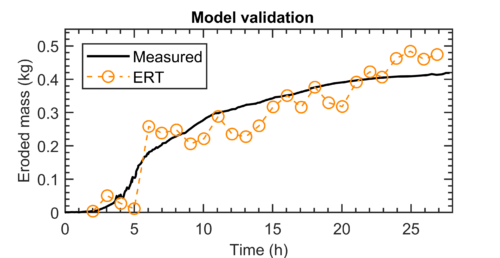Internal erosion in river levees and dams
Seepage in earthen structures, such as dams and river levees, can induce “internal erosion” phenomena which can severely impact the mechanical behavior and the stability of these structures.
These erosion processes can pose major risks, including even dam failure and levee breaches. The study of these phenomena has faced limitations as they take place hidden within the material, making them challenging to detect and track. However, non-destructive geophysical monitoring techniques offer valuable means to gain understanding about these processes.


In this study, we developed a procedure for evaluating internal erosion processes using three-dimensional electrical resistivity tomography.
Objectives
- Evaluate the use of non-destructive methods (resistivity tomography) to identify internal erosion processes in embankments and earthen dams
- Develop a model to simulate internal erosion processes by calculating the mass of eroded material over time
- Calibrate and validate the model through measurements and experimental data
- Use the calibrated model to quantitatively interpret resistivity tomography results
Results
Model test and validation
The model was validated against data measured in the laboratory. Once calibrated, the model is able to “convert” resistivity measurements (ERT, “Electrical Resistivity Tomography”) to mass of material eroded by the action of water infiltration.


Benefits
Time-lapse electrical resistivity tomography technique is potentially capable of detecting the location of the erosion processes in dams and levees and, foremost, provide a quantification of the eroded mass.

Read more
Masi M., Ferdos F., Losito G., Solari L. (2020). Monitoring of internal erosion processes by time-lapse electrical resistivity tomography. Journal of Hydrology, 589, 125340. DOI: 10.1016/j.jhydrol.2020.125340







